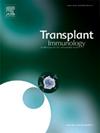High seroprevalence of CMV among Algerian hemodialysis patients and the general population: Intermediate-risk patients for post-transplant CMV infection
IF 1.4
4区 医学
Q4 IMMUNOLOGY
引用次数: 0
Abstract
Introduction
Cytomegalovirus (CMV) is a virus of the herpesviridae family. CMV infection is associated with increased morbidity and mortality in immunocompromised subjects such as hemodialysis patients and transplant recipients. The aim of our study was to determine the serological status of potential kidney recipients and donors in order to assess the risk of post-transplant CMV infection and disease.
Patients and methods
We included 135 and 200 potential kidney transplant donors and recipients, respectively, who were tested for anti-CMV IgM and IgG by chemiluminescence on IMMULITE 2000 XPI®.
Results
The prevalence of anti-CMV IgG was 95.50 % (95 % CI [92.63 %–98.37 %]) in hemodialysis patients and 96.30 % (95 % CI [93.12 %–99.48 %]) in potential kidney donors. The difference between the two groups was not significant (p = 0.721). Anti-CMV IgM were only detected in the sera of 13 hemodialysis patients and 3 healthy subjects. In both groups, the highest rate of anti-CMV IgG positivity was observed in subjects aged over 50 years (100 %), followed by those aged between 18 and 30 years old, with a slightly higher seroprevalence in men than in women.
Conclusion
Our results suggest a high prevalence of anti-CMV IgG in potential kidney donors and recipients (D+/R+), who could be classified as an intermediate risk group for post-transplant CMV infection and/or disease.
阿尔及利亚血液透析患者和一般人群中巨细胞病毒的高血清阳性率:移植后巨细胞病毒感染的中等风险患者
巨细胞病毒(CMV)是疱疹病毒科的一种病毒。巨细胞病毒感染与免疫功能低下患者(如血液透析患者和移植受者)的发病率和死亡率增加有关。本研究的目的是确定潜在肾受体和供体的血清学状态,以评估移植后CMV感染和疾病的风险。患者和方法:我们分别纳入了135名和200名潜在的肾移植供者和受体,他们在IMMULITE 2000 XPI®上进行了抗cmv IgM和IgG的化学发光检测。结果:血液透析患者中抗巨细胞病毒IgG的患病率为95.50 %(95 % CI[92.63 %-98.37 %]),潜在肾脏供者中抗巨细胞病毒IgG的患病率为96.30 %(95 % CI[93.12 %-99.48 %])。两组间差异无统计学意义(p = 0.721)。抗巨细胞病毒IgM仅在13例血液透析患者和3例健康人血清中检测到。在两组中,抗巨细胞病毒IgG阳性率最高的是年龄在50 岁以上的受试者(100 %),其次是年龄在18 - 30 岁之间的受试者,男性的血清阳性率略高于女性。结论:我们的研究结果表明,抗巨细胞病毒IgG在潜在肾供者和受体(D+/R+)中有很高的患病率,他们可以被归类为移植后巨细胞病毒感染和/或疾病的中间危险群体。
本文章由计算机程序翻译,如有差异,请以英文原文为准。
求助全文
约1分钟内获得全文
求助全文
来源期刊

Transplant immunology
医学-免疫学
CiteScore
2.10
自引率
13.30%
发文量
198
审稿时长
48 days
期刊介绍:
Transplant Immunology will publish up-to-date information on all aspects of the broad field it encompasses. The journal will be directed at (basic) scientists, tissue typers, transplant physicians and surgeons, and research and data on all immunological aspects of organ-, tissue- and (haematopoietic) stem cell transplantation are of potential interest to the readers of Transplant Immunology. Original papers, Review articles and Hypotheses will be considered for publication and submitted manuscripts will be rapidly peer-reviewed and published. They will be judged on the basis of scientific merit, originality, timeliness and quality.
 求助内容:
求助内容: 应助结果提醒方式:
应助结果提醒方式:


